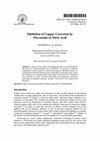Equilibrium and Kinetics Study of Adsorption of Crystal Violet onto the Peel of Cucumis sativa Fruit from Aqueous Solution
引用次数: 23
Abstract
The use of low-cost, locally available, high efficiency and eco-friendly adsorbents has been investigated as an ideal alternative to the current expensive methods of removing dyes from wastewater. This study investigates the potential use of the peel of Cucumis sativa fruit for the removal of crystal violet (CV) dye from simulated wastewater. The effects of different system variables, adsorbent dosage, initial dye concentration, pH and contact time were investigated and optimal experimental conditions were ascertained. The results showed that as the amount of the adsorbent increased, the percentage of dye removal increased accordingly. Optimum pH value for dye adsorption was determined as 7.0. The adsorption of crystal violet followed pseudo-second order rate equation and fit well Langmuir and Freundlich equations. The maximum removal of CV was obtained at pH 7 as 92.15% for adsorbent dose of 0.2 g/50 mL and 25 mg L-1 initial dye concentration at room temperature. The maximum adsorption capacity obtained from Langmuir equation was 34.24 mg g-1. Furthermore, adsorption kinetics of (CV) was studied and the rate of adsorption was found to conform to pseudo-second order kinetics with a good correlation (R2 > 0.9739). The peel of Cucumis sativa fruit can be attractive options for dye removal from diluted industrial effluents since test reaction made on simulated dyeing wastewater show better removal percentage of (CV).紫晶在黄瓜果皮上吸附的平衡及动力学研究
研究了低成本、本地可得、高效和环保的吸附剂作为目前昂贵的废水脱除染料方法的理想替代方法。研究了黄瓜果皮对模拟废水中结晶紫染料的去除效果。考察了吸附剂用量、初始染料浓度、pH值和接触时间等不同体系变量对吸附效果的影响,确定了最佳实验条件。结果表明,随着吸附剂用量的增加,染料去除率也相应提高。染料吸附的最佳pH值为7.0。结晶紫的吸附符合拟二级速率方程,符合Langmuir方程和Freundlich方程。当吸附剂用量为0.2 g/50 mL,室温初始染料浓度为25 mg L-1时,pH为7时,对CV的去除率为92.15%。由Langmuir方程得到的最大吸附量为34.24 mg g-1。对(CV)的吸附动力学进行了研究,发现吸附速率符合准二级动力学,并具有良好的相关性(R2 > 0.9739)。由于在模拟染色废水上进行的试验反应显示出更好的去除率(CV),因此黄瓜果皮可以作为稀释工业废水中染料去除的有吸引力的选择。
本文章由计算机程序翻译,如有差异,请以英文原文为准。
求助全文
约1分钟内获得全文
求助全文

 求助内容:
求助内容: 应助结果提醒方式:
应助结果提醒方式:


